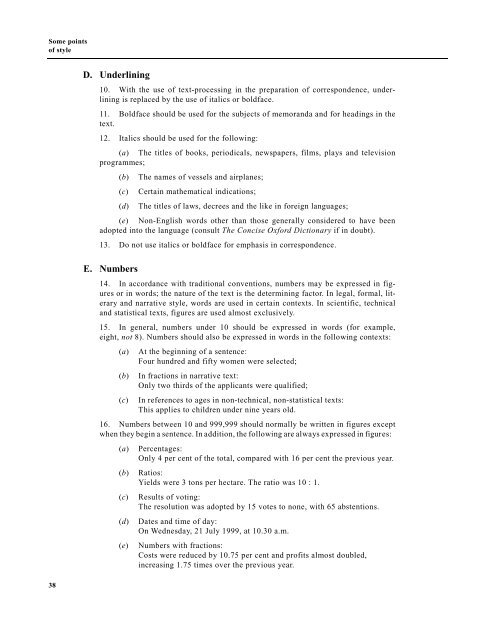United Nations Correspondence Manual - UNU
United Nations Correspondence Manual - UNU
United Nations Correspondence Manual - UNU
Create successful ePaper yourself
Turn your PDF publications into a flip-book with our unique Google optimized e-Paper software.
Some points<br />
of style<br />
38<br />
D. Underlining<br />
10. With the use of text-processing in the preparation of correspondence, underlining<br />
is replaced by the use of italics or boldface.<br />
11.<br />
text.<br />
Boldface should be used for the subjects of memoranda and for headings in the<br />
12. Italics should be used for the following:<br />
(a) The titles of books, periodicals, newspapers, films, plays and television<br />
programmes;<br />
(b) The names of vessels and airplanes;<br />
(c) Certain mathematical indications;<br />
(d) The titles of laws, decrees and the like in foreign languages;<br />
(e) Non-English words other than those generally considered to have been<br />
adopted into the language (consult The Concise Oxford Dictionary if in doubt).<br />
13. Do not use italics or boldface for emphasis in correspondence.<br />
E. Numbers<br />
14. In accordance with traditional conventions, numbers may be expressed in figures<br />
or in words; the nature of the text is the determining factor. In legal, formal, literary<br />
and narrative style, words are used in certain contexts. In scientific, technical<br />
and statistical texts, figures are used almost exclusively.<br />
15. In general, numbers under 10 should be expressed in words (for example,<br />
eight, not 8). Numbers should also be expressed in words in the following contexts:<br />
(a) At the beginning of a sentence:<br />
Four hundred and fifty women were selected;<br />
(b) In fractions in narrative text:<br />
Only two thirds of the applicants were qualified;<br />
(c) In references to ages in non-technical, non-statistical texts:<br />
This applies to children under nine years old.<br />
16. Numbers between 10 and 999,999 should normally be written in figures except<br />
when they begin a sentence. In addition, the following are always expressed in figures:<br />
(a) Percentages:<br />
Only 4 per cent of the total, compared with 16 per cent the previous year.<br />
(b) Ratios:<br />
Yields were 3 tons per hectare. The ratio was 10 : 1.<br />
(c) Results of voting:<br />
The resolution was adopted by 15 votes to none, with 65 abstentions.<br />
(d) Dates and time of day:<br />
On Wednesday, 21 July 1999, at 10.30 a.m.<br />
(e) Numbers with fractions:<br />
Costs were reduced by 10.75 per cent and profits almost doubled,<br />
increasing 1.75 times over the previous year.




